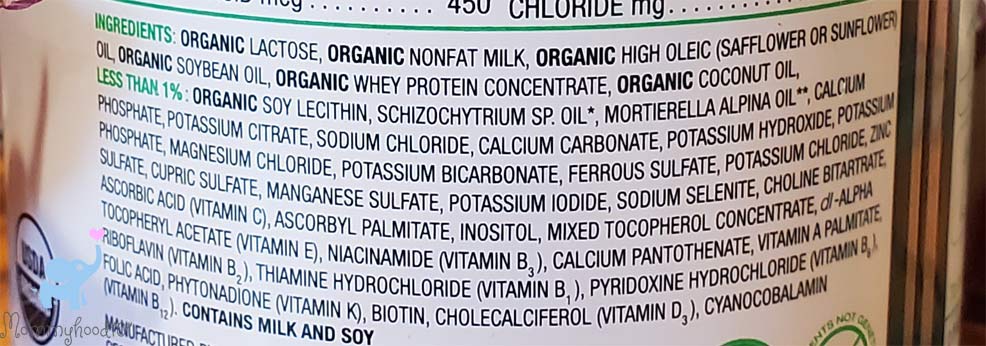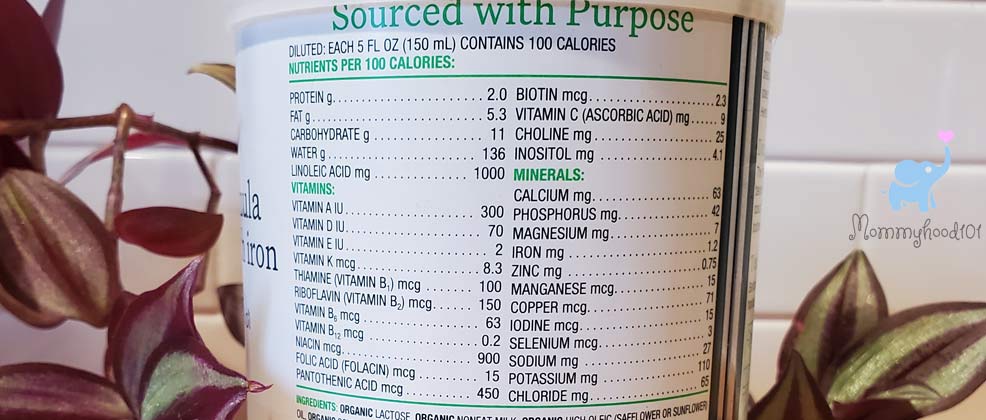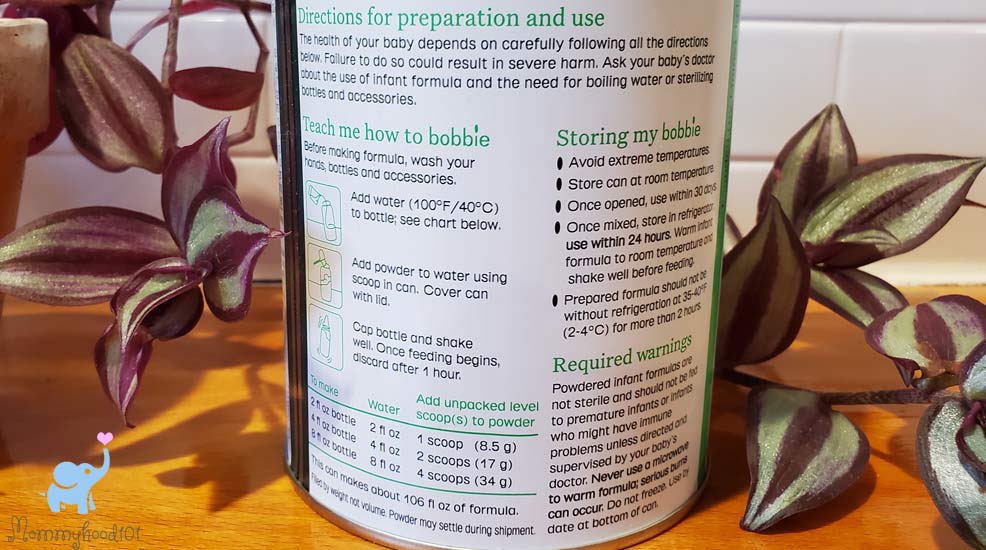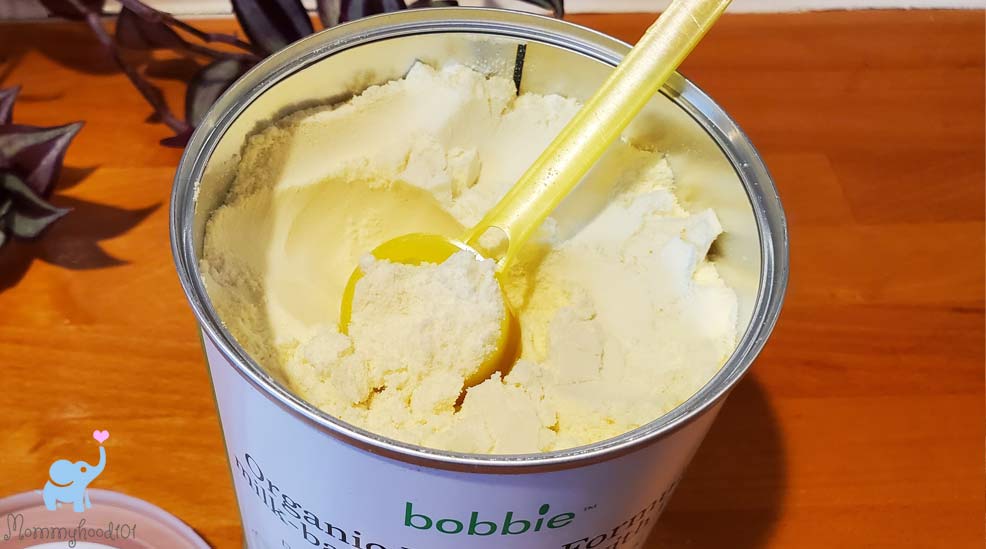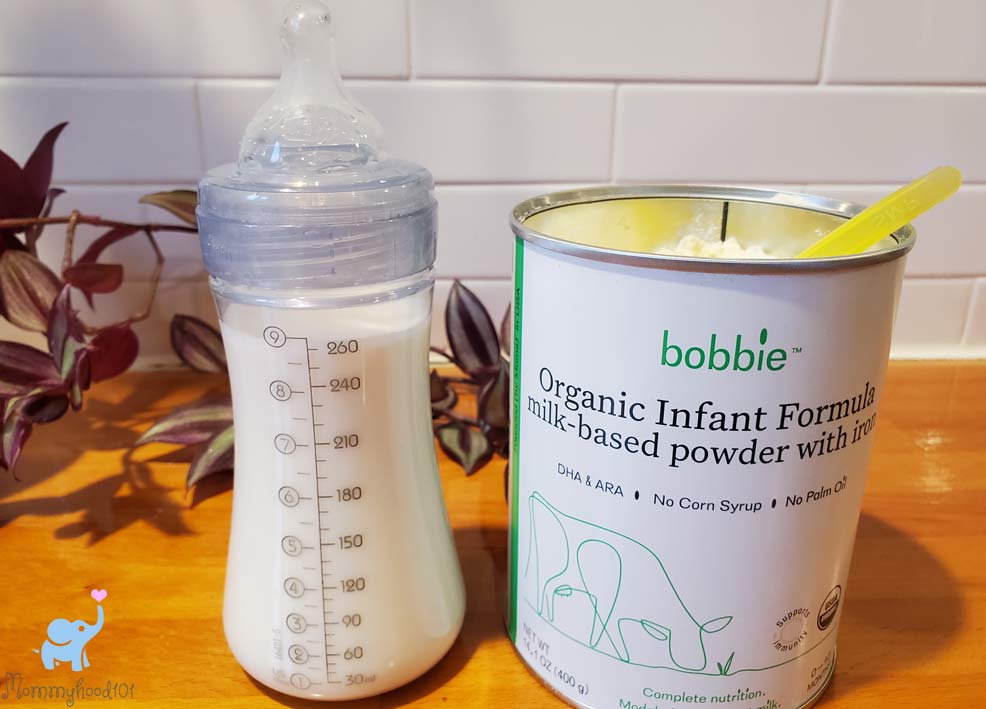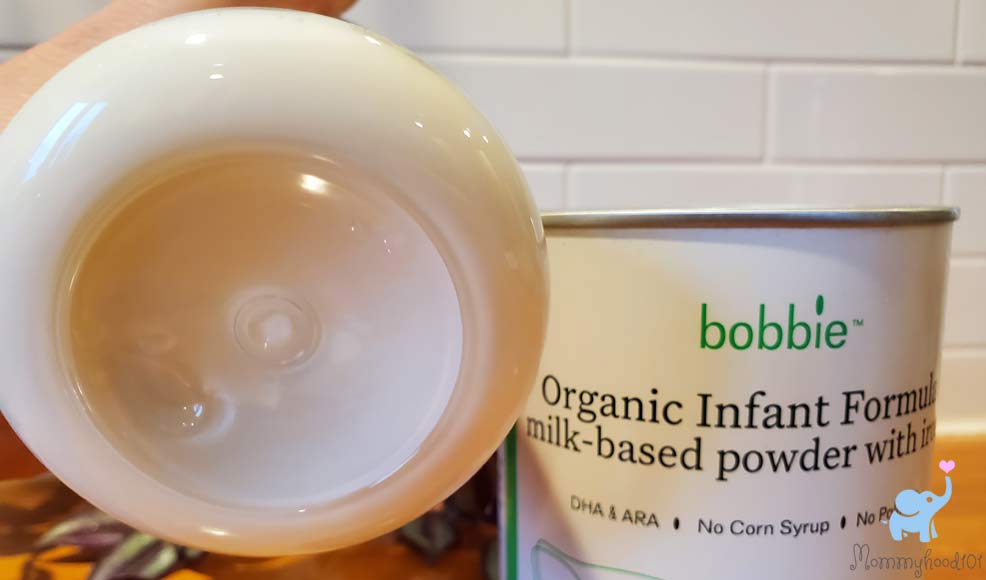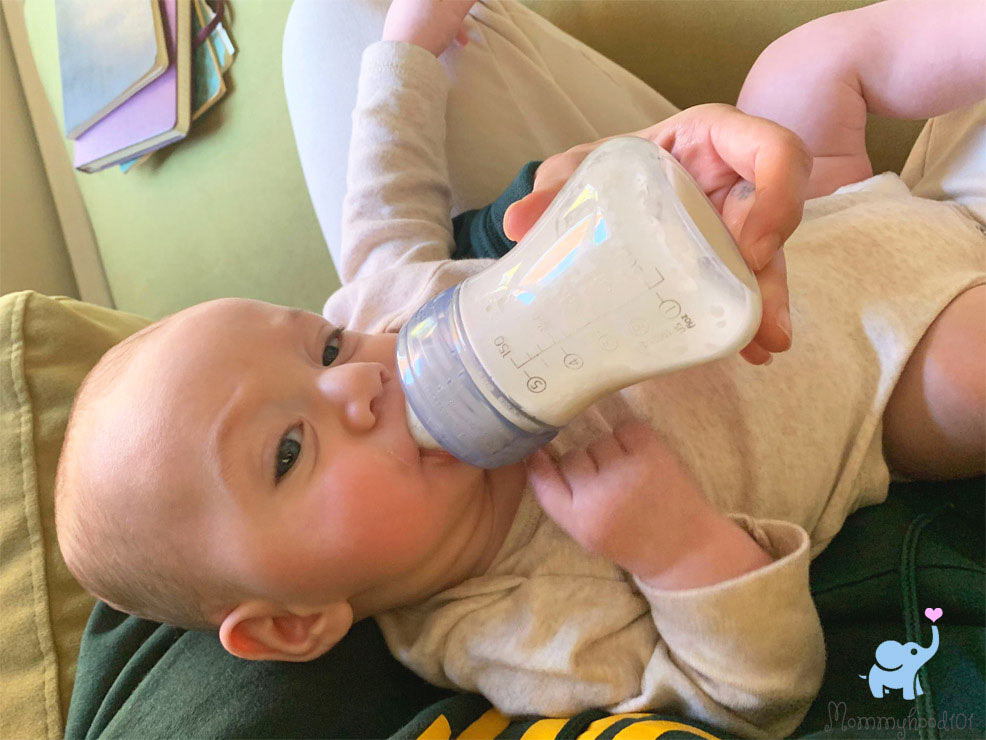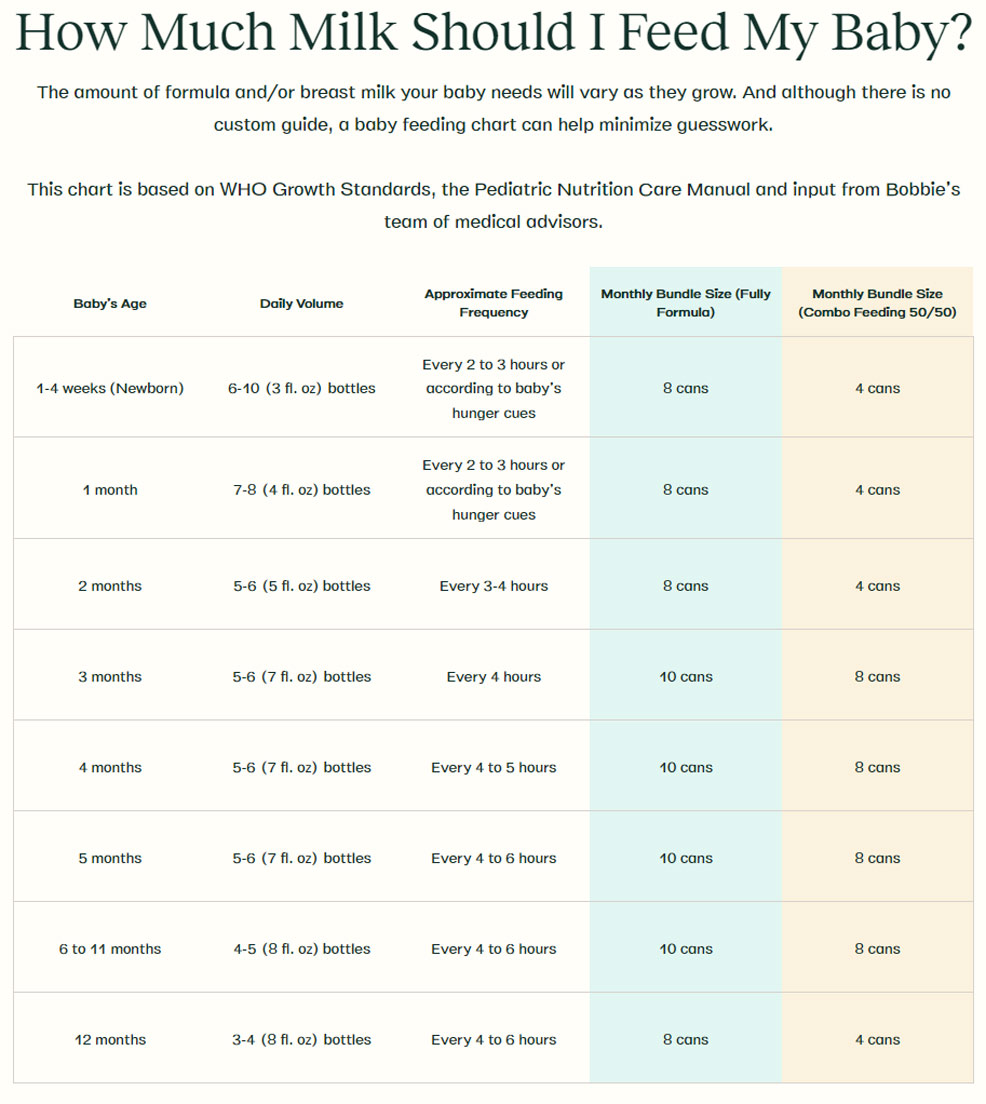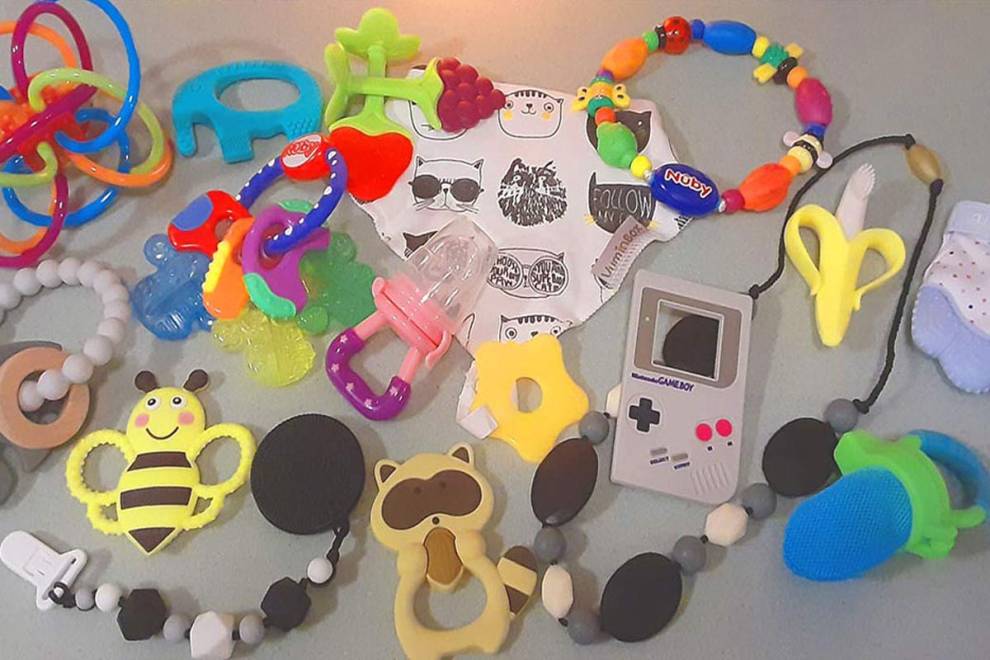Is your baby Bobbie-licious? We put this new formula to the test, and loved it!
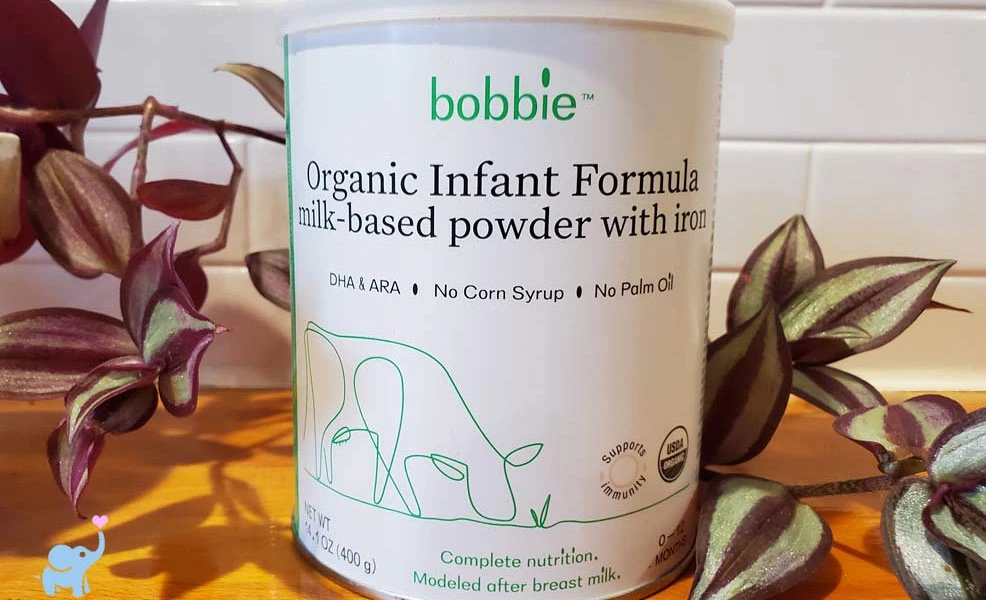
Mommyhood101 independently tests and curates baby gear to help you make informed decisions. If you buy products through links on our site, we may earn a commission.
The new(ish) kid on the block, Bobbie infant formula takes a distinctively European approach to ingredients and nutrition while maintaining local sourcing and manufacturing, reliable availability, and US regulatory compliance.
As of this year, Bobbie makes two baby formulas. First is this original Bobbie formula, what they call their Organic Infant Formula, a milk-based powder with iron, suitable for little ones aged 0-12 months.
Second is their new gentle formulation, which you can read more about in our Bobbie gentle formula review.
On paper, the Bobbie formula looks excellent in terms of its ingredients and nutrition.
But is it one of the best organic formulas on the market? Let's find out!
To review the Bobbie baby formula, we tested it with two infants (4 months and 8 months) and consulted with a developmental nutritionist to assess ingredients and nutritional contents relative to USDA and FDA guidelines.
In a market increasingly saturated by European baby formula options, such as those by HiPP, Holle, Kendamil, and Lebenswert, Bobbie is a highly appreciated new addition from a US manufacturer.
Bobbie Organic Formula: Take-home Message
Most people don't want to read this entire article to see what we found. So here is the summary of what we loved, and what we didn't.
✔️ Organic formulation.
✔️ Nutrition at FDA standards.
✔️ Nutrition at USDA standards.
✔️ First ingredient is lactose.
✔️ Nothing artificial.
✔️ DHA not extracted with hexane.
✔️ No maltodextrin or starch.
✔️ No sucrose.
✔️ No glucose syrup solids.
✔️ Gluten-free.
✔️ Omega-3 via DHA.
✔️ Omega-6 via ARA & LA.
✔️ Inositol & Choline.
✔️ Amino Acids (in nonfat milk).
✔️ High infant acceptance.
✔️ Low gas, indigestion, constipation.
✔️ No palm oil.
❌ No prebiotics or probiotics.
❌ Mortierella Alpina Oil.
❌ Schizochytrium Sp. Oil.
Overall, we think there is a lot to love about the new Bobbie organic infant formula, especially when it comes to ingredients and nutritional composition.
We give the Bobbie formula a 4.6 out of 5, which puts it in direct competition with some of the most popular European brands!
Most infants will not need supplemental prebiotics or probiotics in their formula, and some of the ingredients (such as lactose) have a natural prebiotic effect in the gut.
Regarding the Mortierella Alpina oil and Schizochytrium Sp. oil, these are important sources of DHA and ARA, and they are extracted with water (not hexane). While we prefer natural fish oil, these are an excellent source of essential fatty acids!
Bobbie Formula: Best Practices?
Parents love the simplicity and nutritional value of European baby formulas, but they're not always happy with the lack of FDA oversight, long shipping times, and varied availability.
Enter Bobbie, which managed to make a uniquely European-style infant formula right here in the USA, while also being USDA-certified organic and conforming to stringent FDA regulations.
The American baby formula market is exploding with new organic formula options (check out our ByHeart formula review as well!), and Bobbie jumped into the competition with an organic infant formula that parents are raving about!
Bobbie was founded by two moms, Laura and Sarah, in San Francisco, CA.
Their first baby formula was launched in early 2021, and they manufacture their formulas in Vermont through a contractual arrangement with PBM Nutritionals, LLC.
PBM Nutritionals, which does business as Perrigo Nutritionals, is one of the only ISO 9001:2000-certified infant formula-manufacturing facilities in the United States. They also conform to the Safe Quality Food Program and Quality Assurance International certifications.
According to our research, PBM Nutritionals has over 20 years of manufacturing and packaging infant milk. In addition to Bobbie, they also manufacture the Burt's Bees organic formulas, and several store brand formulas.
At their factory in Vermont, they conduct over 2500 different tests of baby formulas per month, ensuring quality compliance and reliability.
All told, while Perrigo is a large company that produces (and rebrands) generic baby formulas, they do appear to follow a rigid set of standards and certifications.
According to Bobbie, the dairy (lactose, nonfat milk, whey) in their formula is sourced from a cooperative of small family farms, including from Organic Valley pasture-raised cows.
The DHA used in Bobbie, which originates from micro-algae, is sourced from DSM Nutritional Products, makers of the popular Life'sDHA, which is used in nearly all US baby formula brands.
Bobbie Formula Ingredients
The ingredient sourcing for Bobbie is not quite as transparent as some brands, such as Löwenzahn, but their choice of dairy ingredient suppliers such as Organic Valley is reassuring.
The use of ingredients sourced from small organic farms provides some intangible benefits for the quality of infant and toddler formulas.
While these benefits may not appear on an ingredients label, this usually means that there is a lower risk of the products containing all the nasty stuff you don't want to occur (even in trace amounts), like pesticides, herbicides, antibiotics, or heavy metals.
Here are the ingredients in the Bobbie infant formula (as of the late-2021 manufacturing date):
Bobbie Organic Infant Formula Ingredients: ORGANIC LACTOSE, ORGANIC NONFAT MILK, ORGANIC HIGH OLEIC (SAFFLOWER OR SUNFLOWER) OIL, ORGANIC SOYBEAN OIL, ORGANIC WHEY PROTEIN CONCENTRATE, ORGANIC COCONUT OIL, LESS THAN 1%: ORGANIC SOY LECITHIN, SCHIZOCHYTRIUM SP. OIL, MORTIERELLA ALPINA OIL, CALCIUM PHOSPHATE, POTASSIUM CITRATE, SODIUM CHLORIDE, CALCIUM CARBONATE, POTASSIUM HYDROXIDE, POTASSIUM PHOSPHATE, MAGNESIUM CHLORIDE, POTASSIUM BICARBONATE, FERROUS SULFATE, POTASSIUM CHLORIDE, ZINC SULFATE, CUPRIC SULFATE, MANGANESE SULFATE, POTASSIUM IODIDE, SODIUM SELENITE, CHOLINE BITARTRATE, ASCORBIC ACID (VITAMIN C), ASCORBYL PALMITATE, INOSITOL, MIXED TOCOPHEROL CONCENTRATE, DL-ALPHA TOCOPHERYL ACETATE (VITAMIN E), NIACINAMIDE (VITAMIN B3), CALCIUM PANTOTHENATE, VITAMIN A PALMITATE, RIBOFLAVIN (VITAMIN B2), THIAMINE HYDROCHLORIDE (VITAMIN B1), PYRIDOXINE HYDROCHLORIDE (VITAMIN B6), FOLIC ACID, PHYTONADIONE (VITAMIN K), BIOTIN, CHOLECALCIFEROL (VITAMIN D3), CYANOCOBALAMIN (VITAMIN B12). Contains Milk and Soy.
Important note: As of 2023, Bobbie replaced the organic soybean oil with organic canola oil. They also replaced the soy lecithin with organic canola lecithin. These two changes make the Bobbie formula more attractive for families with soy sensitivities. We will be updating this article with a review of their newest formulation soon!
We love that the primary carbohydrate is lactose, just like breast milk!
Here are some ingredients that we did not find in Bobbie formula: palm oil, starch, maltodextrin, artificial colors, artificial flavors, preservatives, sucrose, gluten, genetically modified organisms (GMOs), carrageenan, or high fructose corn syrup.
Some questionable ingredients:
Schizochytrium Sp. Oil: There are basically two primary ways to get DHA (docosahexaenoic acid, an important Omega-3 fatty acid found in breast milk) into baby formula. The first is by adding fish oil, and the second is by adding algae oil. Bobbie, like most US formula manufacturers, decided to add algae oil, specifically schizochytrium sp. oil, which is oil extracted from freshwater microalgae. This oil is an excellent source of DHA, containing up to 40% DHA content. While some baby formula manufacturers use potentially hazardous chemicals to extract DHA from this oil, such as hexane, Bobbie uses a water-based extraction method. So while we prefer the use of DHA from fish oil, which is more common in European baby formulas, this ingredient is perfectly fine as a DHA source.
Mortierella Alpina Oil: This oil is an excellent source of ARA (arachidonic acid, an important Omega-6 fatty acid found in breast milk), which most adults introduce into their diets through eggs, poultry, and meat. Mortierella Alpina is a fungus that is fermented and has an ARA-rich oil extracted from it. Mortierella Alpina oil is considered generally safe for infant consumption, though there has been some controversy (particularly among parents reporting diarrhea and other symptoms) surrounding its use.
Soybean Oil: Some parents get concerned about soy oil due to fear of residual pesticides from farming practices, genetic modification or crop engineering, or hydrogenation of the soy oils (which can produce trans fats). However, the fact that Bobbie formula contains organic soybean oil should mitigate these fears. Also, note that there is no evidence of phytoestrogens being present in soy oils, so there are none of the typical concerns about estrogen-like compounds altering reproductive system development.
As of 2023, Bobbie removed the soybean oil from their formulas!
Bobbie Formula Nutritional Analysis
To examine whether Bobbie formula comes close to the stringent nutritional recommendations put forth by the US Department of Agriculture (USDA, see references), Food and Drug Administration (FDA), and American Academy of Pediatrics (AAP), we consulted with a dietician nutritionist with expertise in infant feeding (Mr. John Anderson).
Note that the FDA publishes guidance in 21 U.S. Code 350a regarding nutrient requirements in infant formula. This regulation includes minimum protein, fat (and fatty acid linoleate) content. It also includes ranges for 15 vitamins and 11 minerals.
Here are the FDA requirements per 100 kilocalories of formula (see references):
FDA Nutritional Requirements:
| Protein | 0-6mo: 1.8g to 4.5g |
| Fat | 0-6mo: 3.3g to 6.0g (≥ 30% of calories) |
| Essential Fatty Acid (LA Omega-6) | 0-6mo: ≥300mg (≥2.7% of calories) |
| Vitamin A | 0-6mo: 250IU to 750IU (75-225μg if retinol) |
| Vitamin D | 0-6mo: 40IU to 100IU |
| Vitamin K | 0-6mo: ≥4μg |
| Vitamin E | 0-6mo: 0.7IU |
| Vitamin C | 0-6mo: ≥8mg |
| Vitamin B1 | 0-6mo: ≥40μg |
| Vitamin B2 | 0-6mo: ≥60μg |
| Vitamin B6 | 0-6mo: ≥35μg |
| Vitamin B12 | 0-6mo: ≥0.15μg |
| Niacin | 0-6mo: ≥250μg |
| Folic Acid | 0-6mo: ≥4μg |
| Pantothenic Acid | 0-6mo: ≥300μg |
| Biotin | 0-6mo: ≥1.5μg (for non-milk-based formulas) |
| Choline | 0-6mo: ≥7mg (for non-milk-based formulas) |
| Inositol | 0-6mo: ≥4mg (for non-milk-based formulas) |
| Calcium | 0-6mo: ≥50mg |
| Phosphorus | 0-6mo: ≥25mg |
| Magnesium | 0-6mo: ≥6mg |
| Iron | 0-6mo: ≥0.15mg |
| Iodine | 0-6mo: ≥5μg |
| Zinc | 0-6mo: ≥0.5mg |
| Copper | 0-6mo: ≥60μg |
| Manganese | 0-6mo: ≥5μg |
| Sodium | 0-6mo: 20mg to 60mg |
| Potassium | 0-6mo: 80mg to 200mg |
| Chloride | 0-6mo: 55mg to 150mg |
In our review of the Bobbie formula, we found that it met all of the minimum FDA nutritional requirements (and did not exceed any of their maximums).
Here is a photo of the Bobbie nutrition facts:
The USDA does not publish recommended daily allowances (RDAs) for infants between 0-6 months. Instead, they publish information about Adequate Intake (AI), which is used when there is not enough evidence to make a formal RDA. The AI is set at a level assumed to provide nutritional adequacy.
Here are the USDA's AIs (per day) for infants aged 0-6 months, and 6-12 months. Units are grams (g), milligrams (mg), micrograms (μg).
USDA Nutritional Recommendations:
| Carbohydrates | 0-6mo: 60g | 6-12mo: 95g |
| Proteins | 0-6mo: 9.1g | 6-12mo: 11g |
| Fats | 0-6mo: 31g | 6-12mo: 30g |
| Omega-3 | 0-6mo: 0.5g | 6-12mo: 0.5g |
| Omega-6 | 0-6mo: 4.4g | 6-12mo: 4.6g |
| Vitamin A | 0-6mo: 400μg | 6-12mo: 500μg |
| Vitamin B1 | 0-6mo: 0.2mg | 6-12mo: 0.3mg |
| Vitamin B2 | 0-6mo: 0.3mg | 6-12mo: 0.4mg |
| Vitamin B6 | 0-6mo: 0.1mg | 6-12mo: 0.3mg |
| Vitamin B12 | 0-6mo: 0.4μg | 6-12mo: 0.5μg |
| Vitamin C | 0-6mo: 40mg | 6-12mo: 50mg |
| Vitamin D | 0-6mo: 5μg | 6-12mo: 5μg |
| Vitamin E | 0-6mo: 4mg | 6-12mo: 5mg |
| Vitamin K | 0-6mo: 2μg | 6-12mo: 2.5μg |
| Folate | 0-6mo: 65μg | 6-12mo: 80μg |
| Niacin | 0-6mo: 2mg | 6-12mo: 4mg |
| Calcium | 0-6mo: 210mg | 6-12mo: 270mg |
| Iron | 0-6mo: 0.27mg | 6-12mo: 11mg |
You won't be surprised to learn that the Bobbie formula also meets all of the USDA recommendations.
The only challenge was figuring out exact Omega-3 and Omega-6 contents.
The nutrition facts do disclose that each 100kcal for formula contains 1000mg of linoleic acid, which is an Omega-6 fatty acid. However, we also know that the formulas contain ARA, another Omega-6 fatty acid, but the amount is not disclosed on the nutrition label. Similarly, we also know that the formulas contain DHA, an Omega-3 fatty acid, but the amount is not disclosed on the nutrition label.
Note that disclosing these amounts on a nutrition label is not required in the USA (it's only required for linoleic acid).
Because parents interested in European baby formulas tend to be interested in DHA content, Bobbie discloses that every 100 calories of Bobbie formula contain 20 milligrams of DHA, which meets EU requirements for infant formulas. We did not find any additional information about the exact ARA content in Bobbie formula.
Bobbie Testing in Infants
We were excited to test the Bobbie formula for a few reasons.
First, Bobbie uses a 60:40 whey-to-casein ratio, which is very similar to breast milk. Also similar to breast milk, they use lactose as a primary carbohydrate.
Second, we've heard only great things about Bobbie since their release. Several parents have reached out to us on social media and email to express their happiness with Bobbie, and we share the sentiment!
Mixing and Taste-Testing
Bobbie mixes extremely quickly and well with warm water (they say to use water at about 100 degrees F): there wasn't any foaming or bubbling after vigorous shaking, which is always a good sign.
To prepare the formula, we followed the instructions: Wash hands, bottles, and accessories. Add water (100 degrees F/40 degrees C) to the bottle, using the provided chart. Add powder to water using a scoop in the can, and close the can. Cap the bottle and shake well.
The powder was a faint yellowish color, just like most other formulas we've tested, and was a smooth and easy texture for scooping. Here is what the formula and scoop looked like:
This is a trivial point, but we were a little annoyed when we first opened the tin of baby formula, for two reasons. First, there was no built-in ledge to help you make level scoops, which is common with many other brands (and super convenient!). Second, the scoop was nowhere to be found, we had to dig around in the formula with a fork to fish it out! A little frustrating, but again not a huge deal.
The mixing went very well! Here is a photo of the prepared Bobbie formula:
The bubbles and foam were minimal and settled very quickly after mixing, which is what we like to see!
Want to learn more about that glass-lined Chicco bottle? Check out our Chicco Duo review, and our list of the Best Baby Bottles of the year!
Picking up the bottle and flipping it over, we checked for any clumping of formula settling at the bottom of the bottle.
We are happy to report that there was absolutely no clumping, and the prepared formula had a very uniform consistency:
Overall, we were very happy with the mixing and preparation of the Bobbie formula and were excited to test it out with two infants: a 4-month-old and 8-month-old.
Safety First: Never prepare powdered formula with anything but water. If you're interested in fortifying your breast milk with formula you must ask your doctor for guidance first, as this can be very dangerous for your baby.
Feeding with Bobbie
We tasted Bobbie ourselves and it was a great balance between sweet and savory while maintaining a relatively subtle taste profile that is unlikely to make babies turn their heads away.
And that's exactly what we found - 100% acceptance of Bobbie on the first try in both babies! That's rare with our baby formula testing, and we were really happy!
Not only did both infants readily accept Bobbie, but they also continued to consume their normal amounts of milk. One of the babies was primarily breastfed, and the other was formula-fed with Similac.
Neither baby developed any apparent gas or discomfort immediately after feeding, and both parents reported that they are seriously considering switching to Bobbie!
Update: After a few months of feeding with Bobbie, one of our test parents reported some issues with excessive spit-up and indigestion, and ended up switching to ByHeart (see our ByHeart review here).
Bobbie Feeding Charts and Auto-Delivery
We would be remiss if we didn't mention one of the most amazing things about Bobbie formulas: their easy-to-understand feeding charts, auto-delivery, and stellar customer service!
One of the challenges parents face when choosing and purchasing a baby formula is figuring out exactly how much formula their babies need, and therefore how much to order.
Well, Bobbie has prepared an amazing table that guides you through estimated feeding quantities during the initial weeks, months, and first years of your baby's life.
Not only is this table helpful for figuring out how much Bobbie you should be feeding, but it is also very helpful for guiding your ordering process.
Bobbie formulas are only available directly through the Bobbie website. One of the amazing features of the Bobbie site is their monthly subscription that mails you formula precisely timed to suit your baby's predicted consumption patterns (with free shipping!).
Even better is how easy it is to modify your order at any time. Baby eating more than you expected and needs some formula sooner? Easy peasy! Need to delay the next shipment by a week or two? No sweat!
Bobbie has made the overwhelming process of picking and purchasing baby formula so much easier for parents, helping them figure out what their babies need, and continually guiding and accommodating them with their flexible auto-delivery.
We love it!
Conclusions
This was our first time trying out the new Bobbie organic infant formula and we absolutely fell in love!
European baby formulas are more popular than ever, but parents are seeking new alternatives that are made in the USA, FDA-regulated, USDA certified, and do not experience shipping delays and unpredictability.
Bobbie filled this gap with a truly remarkable organic infant formula that uses a European-style formulation with excellent ingredient and nutritional composition, shows universal acceptance and tolerance among our test babies, and is managed by a company with a strongly mom-focused customer service ethos.
In terms of ingredients and nutritional contents, we think Bobbie is great, and it provides the perfect balance between what parents expect from an EU formula while also meeting the US-specific infant formula requirements.
We highly recommend Bobbie formulas for discerning parents looking for a high-quality organic baby formula, with the added bonus of being gently hand-held through the formula-feeding experience.
Where to Buy Bobbie Formulas?
The Bobbie formula is available exclusively through the Bobbie website, where they currently sell each 400g (14.1 ounces) can for $26 (in a 4-pack). You can also now find it at Target.
That's about $1.84 per ounce, making it around the same price as most European baby formulas (such as HiPP Combiotik), but a bit more expensive than most other US organic brands such as Earth's Best and Happy Baby.
A reasonable price for an excellent infant formula that we think you and your baby will love!
References Cited
Consulting Dietician Nutritionist (Mr. John Anderson)
United States FDA Infant Formula Nutrient Requirements (full list is here)
United States USDA Infant Nutritional Needs & Recommendations
Safety of Schizochytrium sp. Oil
Safety of Mortierella Alpina Oil
Disclaimer: To our knowledge, all ingredient and nutritional information contained in this article was accurate at the time of publication. We make no guarantees regarding the accuracy or timeliness of the information. Always read the packaging and instructions, and consult with your child's pediatrician before making nutritional and feeding decisions. Baby formulas manufactured and labeled for sale in Europe may or may not be approved for sale in the USA by the FDA or other regulatory bodies, so consumer discretion is advised.



